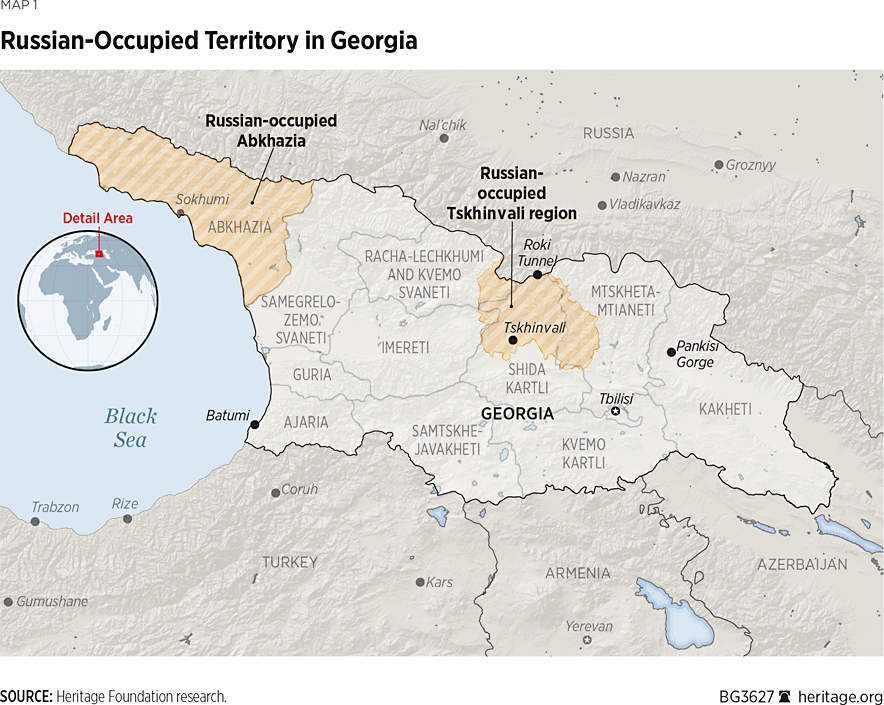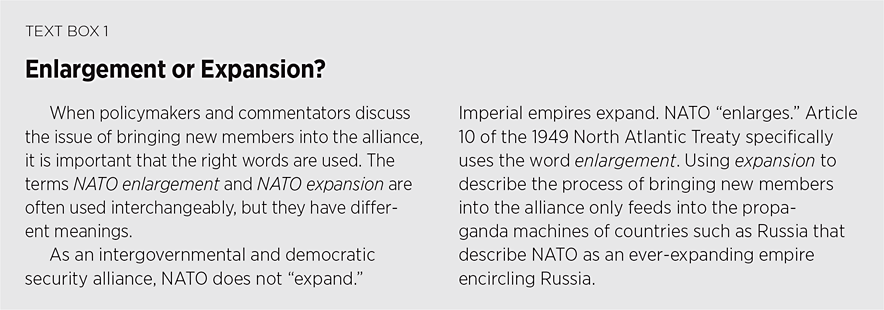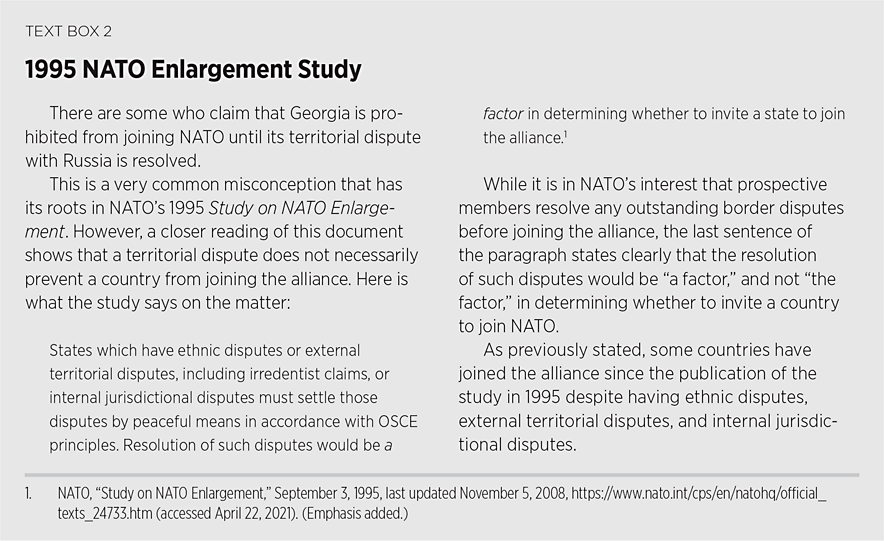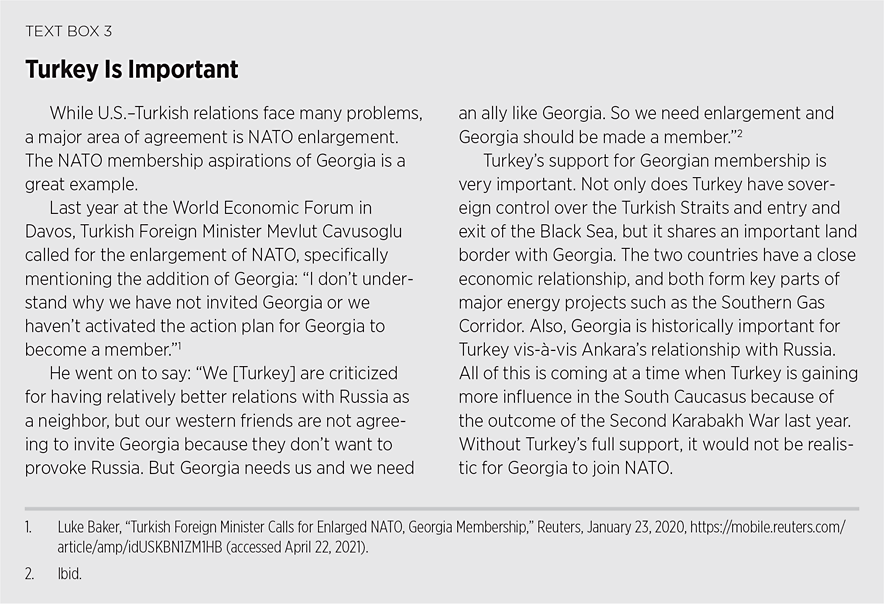It has been more than a decade since Georgia was promised eventual membership in the North Atlantic Treaty Organization (NATO) at the 2008 Bucharest Summit. Russia invaded Georgia later that year and continues to occupy Abkhazia and the Tskhinvali region (more commonly known as South Ossetia).REF After years of economic, governance, and military reforms, this partial occupation remains the primary roadblock to meaningful progress on Georgia’s NATO aspirations. Other NATO members do not want to risk a confrontation with Russia by inviting Georgia to join the alliance.
Russia has perfected a formula to block the Euro-Atlantic aspirations of its neighbors: invasion and partial occupation. Moscow applied this formula to Georgia in 2008 and Ukraine in 2014 on the eve of that country signing an Association Agreement with the European Union (EU). Moldova shares a similar situation over Transnistria.
Russia’s malign actions in Georgia, Ukraine, and Moldova—and the inability of the transatlantic community to push back—has given Moscow a de facto veto on any future NATO membership. Simply out, Georgia cannot join NATO because the Kremlin wants to keep Georgia out of the alliance more than the alliance wants Georgia in. NATO and Georgian policymakers can either get creative to chart out a realistic and reasonable path to get Georgia into NATO, or they can continue to allow Russia to veto NATO enlargement.
Now is the time for fresh thinking and bold ideas to allow Georgia to join NATO. The United States should push for Georgia’s membership by temporarily amending Article 6 of the 1949 North Atlantic Treaty, replacing the current Membership Action Plan process with something more applicable to the geopolitical circumstances of the remaining candidate countries, and working closely with NATO allies in Central and Eastern Europe to build a coalition of support for such moves. Doing this will require political will and strong leadership from the United States, Europe, and Georgia.
Russia’s de Facto Veto
NATO’s open-door policy for qualified countries has contributed greatly to transatlantic security since the first round of enlargement in 1952. It has been a crucial driver of modernization and reform in candidate countries, has promoted stability and peace in Europe, and has made it easier for the alliance to coalesce around collective defense. The North Atlantic Treaty’s Article 10 states that any European state that is “in a position to further the principles of this Treaty and to contribute to the security of the North Atlantic area”REF can be invited to join the alliance.

In April 2008 at the NATO summit in Bucharest, the allies agreed that Georgia will someday become a NATO member and had planned to offer Tbilisi a Membership Action Plan—but then Germany balked.REF This equivocation by the alliance showed that it was neither serious nor unified on the issue of Georgian membership. In August 2008, a mere four months after the summit, and while the world was tuned in to the opening ceremony of the Beijing Summer Olympics, Russia invaded Georgia.

The outcome of this short conflict is still felt today. Thousands of Russian troops occupy the regions of Abkhazia and Tskhinvali, which comprise 20 percent of Georgia’s internationally recognized territory. If a foreign army occupied one-fifth of the contiguous United States, it would be equivalent to all land west of the Rocky Mountains. While Russian aggression remains prevalent in Georgia today in the form of occupation, cyberattacks, and other asymmetrical threats, the most lasting negative impact of the August 2008 war is the de facto veto Moscow now has over Georgia’s future NATO membership.
Time to Think Creatively
Some NATO members are concerned that Georgia’s entry into the alliance would trigger a war with Russia, as Moscow occupies the Tskhinvali and Abkhazia regions. This concern is based on Article 5 of the 1949 North Atlantic Treaty, which offers a security guarantee to its members. As the thinking goes, NATO would be obliged to help its new member Georgia liberate its territory. This does not have to be the case. Georgian officials privately say that they are happy to accept a NATO membership arrangement or compromise that excludes the two occupied regions from NATO’s Article 5 security guarantee until the matter is resolved peacefully with the Russians.
Under this scenario, all of Georgia’s internationally recognized territory, including the Russian-occupied regions of Abkhazia and Tskhinvali, could be invited to join NATO. However, only the areas outside the two occupied regions would get NATO’s Article 5 security guarantee—for now.
To make this work, NATO would amend Article 6 of the 1949 North Atlantic Treaty, which defines where Article 5 applies, to exclude—only temporarily—the Abkhazia and Tskhinvali regions. This amendment to the treaty can be made during Georgia’s accession-protocol process. (See Appendix 1 for an example.) Accession protocols are essentially “amendments or additions to the Treaty, which once signed and ratified by Allies, become an integral part of the Treaty itself and permit the invited countries to become parties to the Treaty.”REF
At the same time, the Georgian government could make a declaration that furthers existing commitments to a peaceful resolution to ending Russia’s occupation. (See Appendix 2 for an example.) This could be based on the declaration made by West Germany in 1954 on the eve of joining NATO regarding reunification with its eastern half.REF However, it should be made clear in this process that amending Article 6 in this way would only be a temporary measure, expiring when Georgia’s full and internationally recognized territory is restored by peaceful means.
There are several reasons why this strategy could be successful:
- This plan is consistent with Georgia’s non-use-of-force pledge for regaining control of the occupied regions. As the Georgian government has already pledged not to use force to regain its occupied regions, an Article 5 security guarantee is unnecessary. This proposal could not work for Ukraine, for example, because Kyiv does not have a non-use-of-force pledge regarding the Donbas region and Crimea.
- There is a precedent of amending or modifying Article 6 in the North Atlantic Treaty. In 1951, just two years after NATO’s formation, the article was amended just before Greece and Turkey joined the alliance. In 1963, the meaning of Article 6 was modified when the North Atlantic Council acknowledged that the article no longer applied to the Algerian Departments of France due to Algeria’s independence. The council decided to keep the wording of the article but stripped the phrase Algerian Departments of France of its legal impact.REF
- Several other NATO members do not have all of their territory under the protection of Article 5. Examples include the United States with its territory of Guam or the state of Hawaii in the Pacific, the U.K. with the Falkland Islands in the south Atlantic, and France with Réunion Island in the Indian Ocean.REF
- There is precedent for countries joining NATO even with ongoing border disputes. For example, Estonia, which joined the alliance in 2004, still does not have a legally agreed upon border with the Russian Federation.REF Croatia, which joined the alliance in 2009, has a border dispute with Serbia along the Danube River.
Create Georgia Stability Areas
Since 2011, Russian and local separatist forces have constructed illegal fencing and earthen barriers in Abkhazia and the Tskhinvali region to separate communities and further divide the Georgian population. Russian and Russian-backed forces have also installed “State Border” signs warning those on the Georgian side of the Administrative Boundary Line (ABL)REF not to enter. Russia has taken even more territory, often meters at a time, in what has been described as Russia’s “creeping annexation.”
There is a legitimate concern about how these creeping annexations could complicate Georgia’s NATO membership prospects if Article 6 is amended to exclude the occupied regions from Article 5 protection. For example, if Russian and separatist forces moved a fence 200 meters into an area along the ABL that was under the control of Georgian authorities, would this constitute an “armed attack” under NATO’s Article 5? Not only is answering a hypothetical question like this impossible, but trying to do so would needlessly divide the alliance. However, leaving a question like this open could invite Russian aggression. Therefore, NATO should address this sensitive and complex issue.
Unsurprisingly, while there is a de facto ABL, it has not been formally demarcated. After all, Abkhazia and the Tskhinvali region remain under illegal Russian occupation, and Tbilisi agreeing to a demarcated border could be seen as an acceptance of this status quo. Consequently, even if Georgia joins NATO with Article 6 amended, it is not clear precisely which areas would actually fall under NATO’s Article 5 protection and which would not.
One proposal to solve this problem is to create two Georgia Stability Areas (GSA).
As part of the 2009 agreement that created the WLZs, Georgian authorities imposed limits on the types of weapons, military vehicles, and military units that can operate within a 12-kilometer zone along the Georgian controlled side of the ABL. For example, Georgia “shall refrain from any significant movement or redeployment of its units of battalion strength or greater and all artillery and mortars with a caliber of 120mm or more, and more than 5 armored vehicles with a caliber more than 60mm but less than 120mm.”REF
Under the terms of the proposed GSAs, the weapons restrictions in the existing WLZs would remain, and another restriction would be added that NATO troops would not enter the 12-kilometer zone at all during peacetime. The only exception would be when NATO military units are in transit on a major highway that passes through the GSA, such as the S3 highway (often referred to as the Georgian Military Road) or the S1 highway (the major east-west highway that is only a few hundred meters from the ABL at its closest point).
Determining the exact width and length for each GSA is not in the scope of this Backgrounder. Instead, a detailed analysis must take place between Georgia, the European Union Monitoring Mission in Georgia (EUMM),REF and NATO to determine the size and scope of each GSA. In particular, important considerations for determining the location of the GSA in the Tskhinvali region must factor in: (1) the location of the existing ABL; (2) the unique topographical and geographical terrain in the region; and (3) the various unique situations on the ground like the Truso Vally,REF the village of Chorchana in Khashuri district,REF and the villages of Kere and Koshka in Gori district,REF for example.
The GSAs are merely a practical tool for NATO contingency planning purposes. They would also remove any ambiguity as to where NATO’s Article 5 protection starts. The territory that falls within GSAs would continue to be patrolled by the EUMM and remain under the control of the Georgian government, as is the case with the current WLZs. While a Russian encroachment into the GSA will not trigger an Article 5 response from NATO, there will still be consequences for Moscow in the form of economic and diplomatic sanctions.
NATO members should create a preemptive package of sanctions that would automatically trigger if Russia or Russian-backed separatists forces encroach into the GSA. Drastic measures—such as limiting Russia’s access, in whole or in part, to the SWIFT banking system—should be considered. It should also be made clear that the creation of GSAs does not change the official position regarding the “occupied” status of Abkhazia and the Tskhinvali region.

Time to Rethink MAP
Another issue that NATO should address when it comes to the current enlargement process is the Membership Action Plan (MAP). MAP is a NATO program that offers assistance and practical support to the individual needs of countries wishing to join. At every NATO summit since 2008, Georgia had hoped to receive a MAP but did not. As the most recent summit declaration states: “We reiterate the decision made at the 2008 Bucharest summit that Georgia will become a member of the alliance, with MAP as an integral part of the process; we reaffirm all elements of that decision, as well as subsequent decisions.”REF It should be stressed that the declaration states that MAP is an integral part—not the integral part—of the membership process.
The MAP process worked well 15–20 years ago when the question of NATO enlargement centered on relatively straightforward cases in Central and Eastern European nations that did not have a partial Russian occupation on their territory. However, it is time to reevaluate the MAP for countries that have unique geopolitical circumstances such as Georgia. Thirteen years after the Bucharest summit, it is clear that the MAP is not helping to create a realistic, reasonable and responsible pathway for Georgia’s NATO membership.
When it comes to current MAP debate regarding Georgia several points are noteworthy:
- What started out as a technical way to bring an aspirant country into the alliance is now, in the case of Georgia, used as a technicality to stop enlargement. Some countries hide behind the more than a decade’s old MAP language in each summit declaration as a reason not to move forward with Georgia’s membership aspirations.
- There is no requirement for a candidate country to either receive or complete a MAP before joining the alliance. The MAP process was created in 1999, and there is no mention of MAP in Article 10 of the 1949 North Atlantic Treaty. The majority of NATO’s members never completed a MAP.
- When a MAP is granted to an aspirant country, this marks the start, and not the end, of the membership process. As the NATO website states: “Participation in the MAP does not prejudge any decision by the alliance on future membership.”REF Due to a name dispute with Greece, North Macedonia’s MAP process lasted 11 years. Bosnia has had a MAP since 2010 with no prospect of membership in sight. Therefore, there is no good reason to continue denying Georgia a MAP.
- Even though Georgia has not received a MAP, it has a relationship with NATO that far exceeds the traditional MAP. The relationship includes the Annual National Program (which consists of almost exactly the same comprehensive reform checklist that countries undergo during the MAP process), the NATO–Georgia Commission, and the Substantial NATO–Georgia Package. The NATO–Georgia Joint Training and Evaluation Centre was opened in August 2015.REF Georgia has also twice contributed an infantry company to the NATO Response Force—quite a commitment for a country that is not a member of the alliance. As NATO Secretary General Jens Stoltenberg said in December 2016, “Georgia has all the practical tools to become a member of NATO.”REF
Members who are hesitant to bring Georgia into the alliance use the issue of MAP as a way to block progress for Tbilisi. Consequently, only the Russians benefit from the disappointment created by the ongoing MAP debate with Georgia. Every summit that goes by without Georgia getting a MAP gives Russia a propaganda victory.
Georgian Leadership Also Needed
Georgians themselves can also help speed along their nation’s membership prospects. Firstly, the Georgian government should at least privately acknowledge to NATO members that will entertain creative and original ideas to join the alliance so long as its territorial integrity is recognized and supported. Ultimately, Tbilisi must first find the political will to support amending Article 6 to speed up accession. Until signals are sent to NATO capitals that the Georgian government is on board, do not expect much movement on this issue from Brussels, Washington, or London.
Secondly, the issue of NATO membership should remain above domestic party politics in Georgia. This issue should be a national effort requiring national unity. The leaders of all the major political parties should sign a joint letter explicitly supporting the idea of temporarily amending Article 6 in order to ease Georgia’s acceptance into NATO. Also, the official Georgian delegation to the next NATO summit or meeting of the next NATO–Georgia Commission should include the leaders of opposition parties who support Georgian membership in the alliance. Henceforth, this should become routine practice. These measures would show NATO members that even though Georgia is a politically divided country (like most democracies around the world), there is political unity on the issue of NATO membership.
The Georgian government would also have to inform and educate the public on what joining NATO by amending Article 6 means and does not mean. Russia would likely launch a disinformation campaign to claim that amending Article 6 to exclude temporarily the occupied regions is proof that the Georgian people really do not want the two regions back. While this is a legitimate concern, it should not prevent policymakers from pursing this proposal. Russia has been conducting a disinformation campaign against the Georgian people and will continue doing so into the foreseeable future regardless of whether policymakers pursue amending Article 6.
Countering Russian disinformation will be crucial for the success of this proposal. Georgian and NATO authorities should get ahead of the debate and launch a public relations campaign explaining the proposal and how it would benefit Georgia and the alliance. During this time it should be made crystal clear that neither the Georgian government nor the United States nor NATO are changing their policies on Georgia’s territorial integrity, which includes Abkhazia and the Tskhinvali region.
Some NATO members will not immediately support this proposal. NATO is an intergovernmental organization that makes all major decisions using unanimity. This is why the process to get Georgia into NATO under the terms outlined here would require strong leadership, a major diplomatic effort, and patience. Policymakers should not expect universal support overnight to admit Georgia into the alliance by amending Article 6, but U.S. leadership can convince reluctant members over time. As the two big powers inside NATO most reluctant to offer Georgia a MAP, Germany and France will likely voice concerns in the beginning about this proposal. This is expected—but at least there will finally be a meaningful debate about a responsible and realistic way to welcome Georgia into the alliance.
The United States should play a leadership role by building a coalition of support for the proposal inside the alliance among Central and Eastern Europeans members who will be more supportive. This should also include working with Turkey—one of the alliance’s strongest supporters of Georgian membership.REF Washington could even leverage its Special Relationship with the U.K. to get London onboard.

Recommendations
While Russia has described any further NATO enlargement as a “provocation,” no third party should have a veto over the sovereign member states of NATO. Rather, it is for the democratic countries that make up the alliance to decide on whether to admit new members. All decisions made by the alliance require unanimity, including those regarding enlargement.
At the time of admitting Greece and Turkey into NATO in 1952, World War II hero General Omar Bradley, while serving as the first chairman of the NATO Military Committee, made the case to U.S. Senators that Greece and Turkey would “bolster [President Dwight D.] Eisenhower’s southeastern flank” and would “serve as powerful deterrents to aggression.”REF Since then, NATO’s southeastern flank has moved due to the addition of many Central and Eastern European members into the alliance after the end of the Cold War. The same argument made in 1952 for Turkey and Greece being accepted into NATO can be made for Georgia today.
Georgian NATO membership would bring more stability to the South Caucasus and transatlantic region. The U.S. government should:
- Push for Georgia’s speedy membership in NATO by temporarily amending Article 6 of the 1949 North Atlantic Treaty. This amendment can be made with Georgia’s accession protocol as it was in 1951 when Turkey and Greece joined the alliance. It is important to point out that this would be only a temporary measure until Georgia’s full, internationally recognized territory is re-established by peaceful and diplomatic means at a future date.
- Start building a coalition inside NATO for amending Article 6. Georgia’s NATO limbo has lasted too long, and the alliance should develop a demonstrable way forward for membership. Many in Central and Eastern Europe will be very supportive of this idea, and the United States should build a coalition inside NATO to push Georgia’s future membership onto the agenda at the next summit. There is plenty of time for U.S. officials to start working with their European counterparts to make this happen.
- Convince Georgian leaders that this plan is a realistic way forward for membership. The Georgian government should make the case to its people that amending Article 6 is a realistic and reasonable way to admit Georgia into NATO and that this idea should not be viewed as the Georgian government, the United States, or NATO changing their policies on Georgia’s territorial integrity (which includes Abkhazia and the Tskhinvali region).
- Involve the EUMM with the GSAs. The EUMM is the established Euro-Atlantic presence on the ground. It also plays an important role along the ABL between Georgia and the occupied regions by showing the world that Georgia is not being provocative. If GSAs (or something similar) are created, then the EUMM will have an important role to play.
- Counter Russian propaganda. Russia will spin this idea as a choice between Georgians joining NATO and Georgians giving up on the two occupied regions. This is a false dichotomy. The Georgian people should never give up their territorial integrity in exchange for NATO membership. Thankfully, this is neither what NATO is asking Georgia to do nor what the proposal to amend Article 6 entails.
- Change the role of MAP in Georgia’s NATO membership aspirations. At the next NATO summit, NATO should omit the phrase with MAP as an integral part of the process from the section about Georgia in the text of its declaration. This would allow the alliance to have a real debate about the applicability and role of MAP for Tbilisi.
- Replace the out-of-date MAP process with something new. When charting a path to membership for Georgia, Bosnia and Herzegovina, and Ukraine, NATO needs a fresh approach. The MAP process worked well when the aspirant countries had relatively straightforward geopolitical circumstances. However, the remaining countries that hope to join have very different circumstances and require more of a bespoke approach by NATO. Also, there is too much political baggage associated with the current MAP process.
- Decouple Georgia’s path to NATO membership from Ukraine. Ukraine and Georgia share many common challenges, especially as they pertain to Russia. However, Georgia’s path toward NATO membership is far ahead of Ukraine’s. This is not meant to be a criticism of Ukraine but merely a reflection of the reality as things stand. However, there is a cautionary note. If anything, fulfilling the promise made in 2008 and getting Georgia into the alliance could inject a new sense of enthusiasm and mission for Ukrainian membership.
Conclusion
Admittedly, amending Article 6 is not without challenges—or even controversy. For it to work, real political leadership is needed in Washington, Brussels, and Tbilisi. The United States will have to convince Europeans that this proposal successfully heads off an automatic war with Russia. The Georgian government will have to explain to its people that it is not abandoning the two occupied regions or the non-use-of-force pledge.
Russia will spin this idea as a choice between Georgians joining NATO and giving up on the two occupied regions. This is a false dichotomy. Georgia had been around in some form or another for 2,000 years before NATO was established and will likely be around for centuries after the Western alliance ceases to exist. NATO should never suggest that the Georgian people give up on their territorial integrity in exchange for NATO membership. Thankfully, this is neither what NATO is asking nor what the plan in this Backgrounder is proposing.
Right now, Russia knows that all it has to do to prevent a country from ever joining NATO is to invade and then partially occupy it. Temporarily amending Article 6 would deny Moscow this veto, starting with Georgia. The only question is whether leaders on both sides of the Atlantic have the required creativity and political will.
Luke Coffey is Director of the Douglas and Sarah Allison Center for Foreign Policy, of the Kathryn and Shelby Cullom Davis Institute for National Security and Foreign Policy, at The Heritage Foundation. James Jay Carafano, PhD, is Vice President of the Davis Institute and E. W. Richardson Fellow at The Heritage Foundation.
Appendix I: Suggested Draft of Georgia’s Accession Protocol
Protocol to the North Atlantic Treaty on the Accession of Georgia. The Parties to the North Atlantic Treaty, signed at Washington on April 4, 1949, Being satisfied that the security of the North Atlantic area will be enhanced by the accession of the Georgia to that Treaty,
Agree as follows:
Article 1
Upon the entry into force of this Protocol, the Secretary General of the North Atlantic Treaty Organization shall, on behalf of all the Parties, communicate to the Government of Georgia an invitation to accede to the North Atlantic Treaty. In accordance with article 10 of the Treaty, Georgia shall become a Party on the date when it deposits its instrument of accession with the Government of the United States of America.
Article 2
If Georgia becomes a Party to the North Atlantic Treaty, Article 6 of the Treaty shall, as from the date of the deposit by the Government of Georgia of its instruments of accession with the Government of the United States of America, be modified to read as follows: For the purpose of Article 5, an armed attack on one or more of the Parties is deemed to include an armed attack:
- on the territory of any of the Parties in Europe or North America, on the Algerian Departments of France, on the territory of Turkey, on the territory of Georgia not under de facto Russian control and located outside the Georgian Stability Areas, or on the islands under the jurisdiction of any of the Parties in the North Atlantic area north of the Tropic of Cancer;
- on the forces, vessels, or aircraft of any of the Parties, when in or over these territories or any other area in Europe in which occupation forces of any of the Parties were stationed on the date when the Treaty entered into force or the Mediterranean Sea or the North Atlantic area north of the Tropic of Cancer.
Article 3
The present Protocol, of which the English and French texts are equally authentic, shall be deposited in the Archives of the Government of the United States of America. Duly certified copies thereof shall be transmitted by that Government to the Governments of all the Parties to the North Atlantic Treaty.
In witness whereof, the undersigned plenipotentiaries have signed the present Protocol.
Signed at Brussels
on the XXth day of XXX 202X.
Appendix 2: Suggested Draft of Georgia’s Declaration of Non-Aggression
Declaration by the Government of Georgia
Georgia has agreed to conduct its foreign policy in accordance with the principles of the Charter of the United Nations and accepts the obligations set forth in Article 2 of the Charter.
Upon her accession to the North Atlantic Treaty, Georgia declares that she will refrain from any action inconsistent with the strictly defensive character of the Treaty. In particular, Georgia undertakes never to have recourse to force to achieve the re-unification of Georgia or the modification of the present boundaries of Georgia, and to resolve by peaceful means any disputes that may arise between the Georgia and other States.


